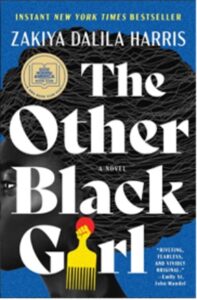
Zakiya Dalila Harris
The Other Black Girl: A Novel
Atria Books 2021
368 pages
$27.00
Reviewed by E. Solaire Denaud
Zakiya Dalila Harris’ debut novel The Other Black Girl: A Novel follows Nella, the only Black woman working at a prestigious publishing house’s almost entirely white office. When Wagner Edition hires another Black woman—Hazel—the reassuring presence of a new Black girl soon becomes a threat, turning what started as a satire of American liberal offices into a horror novel and a thriller. While reading seemingly unrelated chapters featuring four different Black women struggling in the publishing industry, the reader understands that Hazel is part of a conspiracy dating back to the 1980s aimed at shutting down educated Black women’s race consciousness.
Although Harris uses the Black horror trope of the sunken place, The Other Black Girl: A Novel differs from prevailing representations of this trope—as exemplified in Get Out by JordanPeele (2017)—in which the sunken place crystalizes the deepest Black fears. In Harris’ novel, it is unclear if the horror arises from the sunken place or white liberal offices and which one typifies Black horror the best. Contrary to the main character of Get Out, Nella is not forced to enter the sunken place; she chooses it. After years of enduring microaggressions, stagnating in her career, and witnessing daily violence against Black people, Nella is left with a choice: would she prefer enduring daily white-supremacist violence and be aware of it or would she rather turn off her Black consciousness and become a black-skinned-white-masked overachiever, complacent with white people and threatening for other Black girls? With Nella’s final decision to join Hazel in the OBG conspiracy and shut down her political consciousness, Harris offers a different perspective on current conversations around Black horror, as she suggests that—considering the draining daily lives of Black women and the horror already present in it—the sunken place might be attractive to some of them.
Yet—even though the main character chooses the sunken place over her political awareness—Harris is not arguing that Nella’s choice is a quick fix to Black suffering. Instead, she questions the validity of the notion of ‘choice’ in this context. In the novel, the trope of the sunken place appears late, therefore accentuating the satire of liberal offices over the horror and implying that Nella’s daily life is already a type of horror story. Nella chooses the sunken place out of exhaustion and awareness that her intelligence and skills will never be valued, neither in Wagner’s publishing house nor elsewhere. With her dream of becoming Wagner’s first Black editor out of reach, Nella feels that she might as well choose ignorant happiness over bitterness. Thus, the horror does not arise from the sunken place itself but from the exhaustion; a relentless weariness Nella, and highly intelligent Black women like her, continuously endure.
Although Harris’ novel features Black women’s daily nightmare of having to navigate white spaces–which Harris experienced herself, as she worked in the publishing industry for years–the novel does not necessarily read as pessimistic or defeatist. Instead, Harris’ writing appears as a non-judgmental and caring retrospective gaze on her own fatigue while working in the industry. In other words, it is not so much a critique of Nella’s choice but a love letter to all Black girls whom the possibility of giving up might tempt. Interestingly, the novel does not end on Nella’s decision, but on an epilogue featuring a member of a secret society fighting the OBG conspiracy and its rapid propagation throughout the United States, thus closing the story on a call for Black women to resist: “It means, my sisters, we must stay focused. We must come together. And we must continue to resist.”

